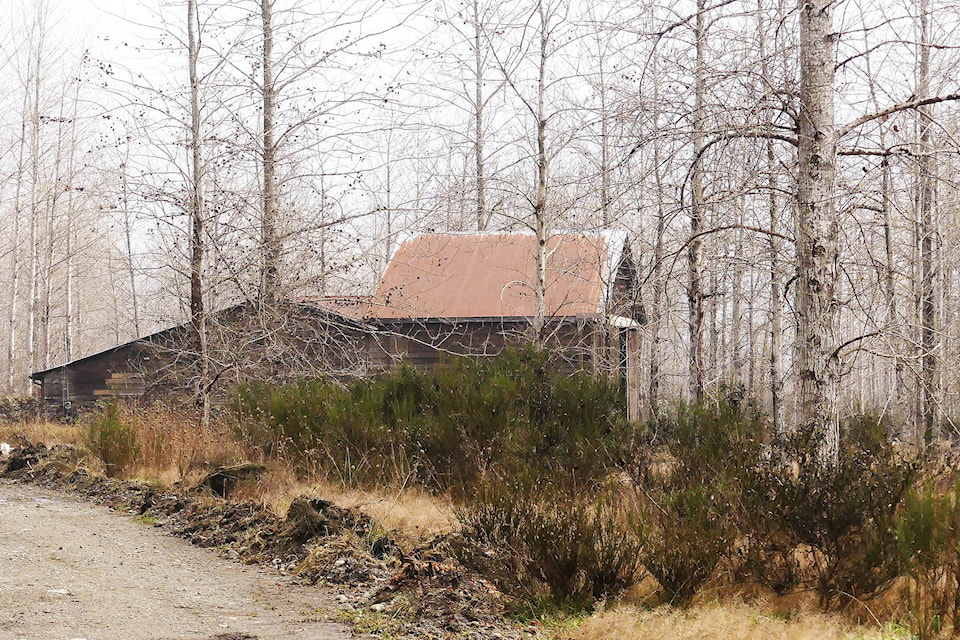BY SANDY MCRUER
Special to the News
I walk by this shed on the west side of the Somass River, near the estuary, maybe 10 times in a year. It reminds me of all that has happened on the other side of the river since European colonization. The road I walk along was graded not so long ago. It’s called the Airport Road in The Google. This shed really is a hangar. It is one of the last vestiges of that “airport”, actually an airstrip.
Before the airport was built the area was farmed. In fact, it was the first farm in the valley and supplied workers in that first sawmill, the one that Stamp built, with fresh veggies. Before that the Tseshaht First Nation had it, and before that, the Hupacasath First Nation, back into the mists of time.
I’m not sure how it came into the hands of McMillan Bloedel, but that’s who owned it when I arrived in 1985. At that time Asker Naesgard was farming vegetables on a few acres leased from the company, the airstrip was operating, there was a weather station there and float planes came and went on the river. Much of the rest of the land grew hay, and it was stored in the barn that stood just near the end of the runway. Over the years the air strip shut down and a bigger airport was built further west, Naesgard quit farming there, the barn burned down, the float planes stopped coming. And both the hayfield and airstrip turned to a pasture for a small herd of horses.
Back around the turn of the century MacMillan Bloedel turfed everyone off the property, plowed it up, and planted special fast-growing hybrid poplars. Despite a couple more plantings the plantation didn’t take well, especially where the planes had landed and taken off.
In 2006, then-owner Catalyst Paper sold this property, and another property behind the Tseshaht Reserve, to the Tseshaht First Nation for $2 million. At the time Chief Councillor Les Sam said: “The transaction clearly indicates the benefits of First Nations working together with industry on initiatives that benefit both of us…This acquisition will help meet the needs of future Tseshaht governments in addressing community and business development opportunities.” The incentive for the purchase was mainly to recover control of land that has been taken from them.
That was 13 years ago. And the poplar plantation is now close to 20 years old. The original plan for the plantation was to harvest 12 years after planting, but that has not happened. The hangar has fallen into an increasingly poor state of disrepair. The area around it is used a bit in the summer and fall to cut firewood for the elders on the reserve. Not much else appears to be happening on it.
This property happens to be the best farmland in the valley. It has the second highest soil capability rating for agriculture in Canada, according to the Canada Land Inventory. And it is in the Agricultural Land Reserve. In the Valley, land like this only occurs in a small area around the mouth of the Somass River and includes the Naesgaard Farm Market, much of the Hupacasath Reserve, Kitsuksis Dyke, Stamp Avenue, the property the paper mill sits on, and lower Third Avenue to Dry Creek. Most of it is currently not used to grow food now, nor are there plans to do so in the immediate future.
In fairness, there are some jurisdictional issues and use restrictions on the property. A third of it is within the boundaries of the City of Port Alberni, and the rest is outside the city. Because it is in the Agricultural Land Reserve options for use are legally limited to uses compatible with agriculture. Also it is susceptible to flooding and tsunami inundation. Accordingly, the City’s Official Community Plan only permits uses such as market gardening on the part of it that is within city limits.
I spoke to Ken Watts, the Tseshaht Councillor for Economic Development about the property. He mentioned that several options have been considered: a campground, a marina, small scale agriculture and formally adding the property to their reserve. Ducks Unlimited has also expressed interest in buying the property. And housing has been considered as the Tseshaht population is growing. But Watts believes that use is more suited to the other part of the purchase, since it is out of the tsunami inundation zone.
Creating a marina and campgrounds are incompatible with the ALR use restrictions. And to have the land withdrawn from the ALR is a long and costly proposition with uncertain results.
I asked him if anyone from outside the band had approached them with a business proposal. He said “We are open to having conversations with any credible business or individual who wants to work in a positive way with Tseshaht. Our community and council actually will be having discussions in the near future on lands we own.” Currently they are putting the finishing touches on a Comprehensive Community Plan that will provide guidance on managing all their properties and the reserve. But it sounded to me that no decisions have been made.
It has been 13 years since the property was purchased. There has been lots of talk over the years. After having seen it go from a productive part of the over-all community here in the Valley to an uncertain future, when food security is on people’s minds, I think it is a pity to see this property languishing without a productive use.
(Sandy McRuer writes a monthly outdoor column for the Alberni Valley News)
